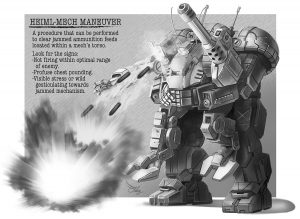Inner Sphere military structure
Sarna News

- Bad ‘Mechs - Sentinel
- HEXTECH Review - Wave 3 Brings More Urban Options To Your Battlefield
- Your BattleTech News Round-Up For March, 2024
- Crashing 'Mechs With Jennifer Brozek, Author Of The Rogue Academy Trilogy
- Getting The Word Out With Rem Alternis, Catalyst Community & Marketing Director
- Read more →
Every military unit in the BattleTech universe, whether regular or mercenary, is divided into sub-units to facilitate organization, deployment, and combat operations. Mercenary units are extremely varied; some, like Carlyle's Commandos were a single lance while others, like Eridani Light Horse and the 12th Star Guards, consist of several regiments.
There is some common terminology for these organizational structure, but there are differences between BattleMech, infantry, and Aerospace Fighter units. There are also disparities between the five great houses and especially between entities in the Periphery. Clan organization is substantially different than any Inner Sphere unit organizations.
Contents
Unit Organization
Each unit is organized differently in practice, but many follow a basic organizational structure that enables them to integrate with other units easily and effectively.
Lance
The lance is the smallest organizational unit. A 'Mech lance consists of four separate BattleMechs, although occasionally a "light lance" consists of only three 'Mechs. A lance commander is usually either a non-commissioned officer (NCO) or a low grade officer (lieutenant or equivalent). Lance commanders are directly engaged in combat operations and are responsible for the 'Mechs under their command.
In addition to four 'Mech pilots, there are normally four to six additional support personnel, making a lance roughly ten individuals. Three lances comprise a company.
Company
A company consists of three lances and normally some ancillary units, usually scout, armor, or artillery. A company commander is normally either a major or captain (or equivalent). The company commander usually the leader of the command lance of a company and is directly involved in combat operations. Companies are more self-sufficient than lances and consist of the combat troops and support personnel, including medical, technician, and planetary transport vehicles (DropShips). Companies may also provide reconnaissance and artillery support lances under its command.
In addition to twelve 'Mech pilots and the eighteen support personnel, there are usually additional support or specialist personnel, making a company roughly sixty individuals. Three companies comprise a battalion. Mercenary units commonly do not exceed the size of a company.
Battalion
A battalion consists of three companies and is a large organization. It is normally composed of at least thirty-six 'Mechs plus aerospace, artillery, reconnaissance, medical, and numerous other support staff and personnel. Overall, a battalion may consist of over two or three hundred individuals. Battalions are commanded by either a lieutenant colonel (or equivalent). Battalion commanders normally do not participate directly in combat operations, but personal preference dictates this. Most battalion commanders direct operations rather than engage enemy forces.
Battalions are extremely self-sufficient and capable fighting forces. They are capable of traveling over the surface of a planet and deploying significant fire power anywhere within a short period of time. Many mercenary units never achieve a size comparable to that of a battalion.
Regiment
Regiments are very large organizations and the great houses normally organize their regular units into regiments. This is traditionally the lowest level of organization that a house's high command will direct (outside of mercenary units). Regiments are commanded by colonels or their equivalent. Regimental commanders rarely engage in combat operations personally; the ability to organize a regimental-sized group is usually not possible on the field of battle. The size of the unit in personnel is not just based upon the combat forces, but it also includes the technical, transportation, scout, and other support personnel and materiel. Regiments are self-sufficient units and usually have their own dedicated DropShips and possibly even JumpShip.
Regiments generally consist of three battalions with much of the transportation and support units reporting either to the commander of the regiment or, in some cases, to the senior battalion commander. Overall, a regiment consists of well over one or two thousand personnel, including over one hundred twenty-six BattleMechs and at least one or two DropShips.
Variations
While the BattleMech organizational structure is common, there are two other unit types that engage in combat operations both in space and on the ground.
Aerospace
As mentioned earlier, aerospace units are half the size of BattleMech units (a lance has two fighters as opposed to four 'Mechs). DropShips and JumpShips are normally not grouped together, but are treated as independent support troops.
Infantry
Infantry is divided into slightly different organizational units that can be integrated into traditional BattleMech units. The structure of an infantry unit is shown below:
- Fire team - consists of four to five individuals
- Squad - comprised of two fire teams (eight to twelve individuals)
- Platoon - comprised of two or more squads plus support personnel (twenty-five to fifty individuals)
- Company - comprised of two or more platoons (seventy to over two hundred individuals)
- Battalion - comprised of two to six companies (three hundred to one thousand individuals)
Combat in the thirty-first and thirty-second centuries has placed far less emphasis on infantry than previous conflicts so it is unusual to see infantry units larger than a company in size. It is common for squads and platoons to support BattleMech operations and to perform general patrol and scout duties.

